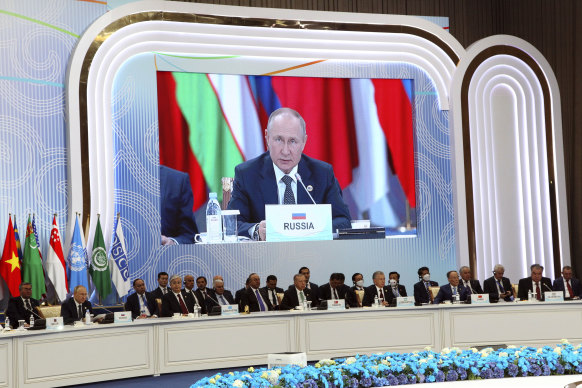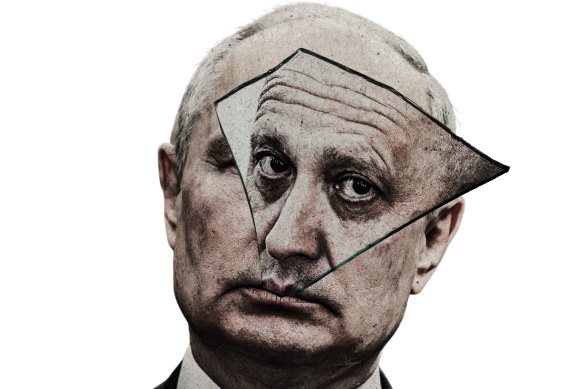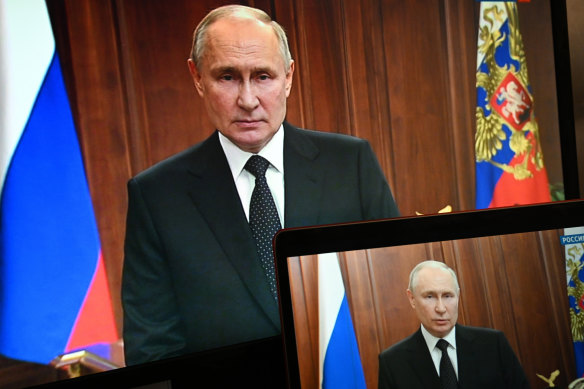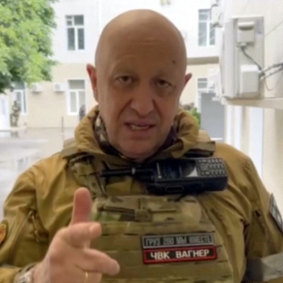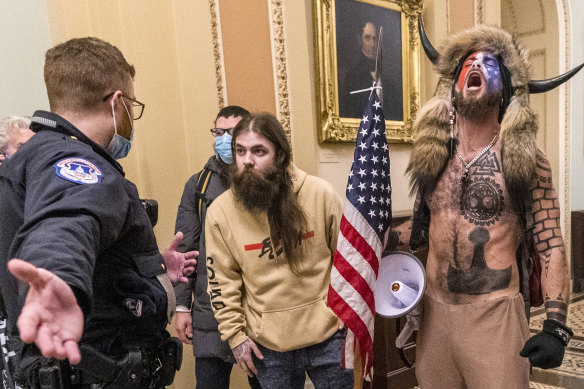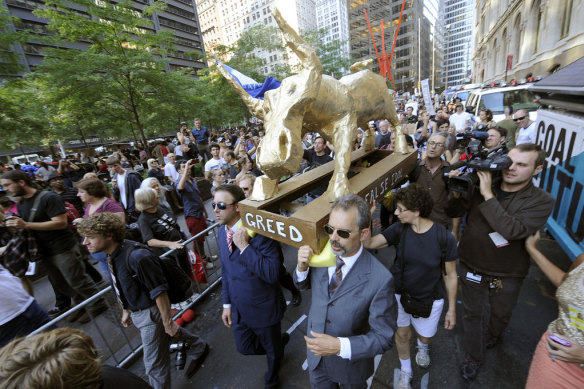There was no plan: An alternative theory of Yevgeny Prigozhin’s mutiny

Save articles for later
Add articles to your saved list and come back to them any time.
Frustrated with how the invasion of Ukraine was playing out, Yevgeny Prigozhin marched toward Moscow one day in late June on what appeared to be a collision course with Vladimir Putin.
He had a platform: He had built up a small media empire. Volatile outbursts he sent via messaging app Telegram were picked up by international media and then amplified by global coverage.
Losing perspective: Russian President Vladimir Putin.Credit: AP
The boss of the Wagner private military group, Prigozhin cut a determined figure: battle-hardened, outrage and angry, but he didn’t intend to seize control of the Kremlin.
So what was Prigozhin doing?
“Yevgeny Prigozhin used Telegram to effectively declare war against the Russian Ministry of Defence, publicly communicating his actions and goals throughout the mutiny,” wrote DFRLab analysts Eto Buziashvili and Iria Puyosa.
With no barrier of speech, Prigozhin’s narrative momentum grew. And how things fared for the Kremlin on Telegram said a lot for how things were going for Putin.
Putin, Prigozhin: the same mistake.Credit: Maria Ercegovac
“The messaging app has become a chronic dilemma for the Kremlin, serving as a vital tool for propagating Russian disinformation over the years, while simultaneously becoming a hotbed for Wagner support and criticism of the Kremlin,” Buziashvili and Puyosa wrote.
The criticism for Russia’s military that Prigozhin posted on Telegram began to take on a runaway momentum which threatened Putin’s legitimacy.
Worse, the Kremlin couldn’t block Telegram, as the platform is one of the few social media platforms it uses to propagate to the masses.
By the time the “Telegram mutiny” ended, Prigozhin had inadvertently exposed Putin’s fragile grip on power. The crisis formed the backdrop of the sit-down Prigozhin had with Putin following his disrupted march.
Putin has always projected power through a maze of screens.Credit: AP
With the risk of damaging Putin a possibility, why did Prigozhin go marching in the first place?
It was possible he was lured by the powerful feedback loop of outrage he himself created on social media.
History is filled with failed coups and revolutions gone bust. In the era of instantaneous communication, though, the trend of leaders, rebels and movements blinded by their own rhetoric has accelerated.
Yevgeny Prigozhin, the owner of the Wagner Group military company.Credit: Prigozhin Press Service via AP
Discussing the effect of the internet on politics more than a decade ago, former US secretary of state Henry Kissinger said of the age of hyper-connectivity: “The empowered citizen knows the technique of getting people to the square, but they don’t know what to do with them when they are in the square.”
An armed and dangerous Prigozhin is a different kind of “empowered citizen”, certainly, but the effect is the same: galvanising support is the easy part. Marshalling the power to achieve a concrete goal is much more difficult.
Prigozhin’s abortive mutiny now resembles Putin’s ill-fated decision to stage a full-scale invasion of Ukraine in 2022.
Both men suffered from self-delusion, likely supercharged by their own echo chamber.
Putin’s idea for invading Ukraine germinated during the leader’s COVID lockdown.
Trump supporters during the attack on the US Capitol on January 6, 2021.Credit: AP
Stewing in nationalistic statements and messianic views of Russian history, the plan could be summarised like this: once Russian tanks streamed across the border, the Ukrainians would simply accept the inevitability of Russian victory and lay down their arms.
Or that was the plan, at least. Neither Putin’s invasion, nor Prigozhin’s mutiny turned out the way either had hoped.
The Ukrainians were far too determined (and well-prepared after eight years of fighting in the country’s east). The Russian people, not to mention, key Russian troops, proved far too ambivalent about who leads the country.
As a person with knowledge of politics in Russia told me: “History teaches us that the majority of people will show their support or at least neutrality to the near most rifle.”
The Occupy Wall Street protest in 2011 was strong on images but light on reform.Credit: AP/Henny Ray Abrams
The events of the past month may be another example of how fleeting and fickle protests and even rebellions have become in the internet-age.
Prigozhin, the owner of the Internet Research Agency, knows the power of propaganda. He has almost 2 million followers on Telegram between his own account and his corporate account, which serves as his own press service.
Before the social media campaigns of Prigozhin’s troll farm were deployed by Putin’s forces on Ukraine, Europe and the US, they were used domestically on Russians.
Yet Prigozhin becoming a victim of his own propaganda is not a uniquely Russian phenomenon.
In 2016, millions of British people, whipped into a frenzy by microtargeted messages, voted for the UK to leave Europe, but with no idea of what Brexit would actually constitute in the real world.
Once the referendum had passed, the public had to determine the reason for it ex post facto.
The assault on the US Capitol in 2021, instigated by then-president Donald Trump, is another example of the disconnect between movements on the internet – in this case, a conspiracy theory that denied Trump’s election loss – and action.
If there was an organised plan to seize power of the US government through force, by armed thugs knowing which doors to smash down and which politicians to kill, Washington could have fallen in a coup.
Instead, there were people milling around the offices and hallways of the Capitol vandalising and taking pictures.
Just act, and ta-da!, the new reality falls into place. Or so the Capitol rioters thought. So Trump thought. So Putin and Prigozhin thought, too.
To date, more than 1033 Capitol riot participants have been arrested, almost 500 have been sentenced, and more than 250 have been jailed.
Processing the legal backlog continues. Jails are a physical reality.
This divide between the will expressed online and the work of organising in the real world can be seen even in the Occupy Wall Street movement of 2011.
People fed up with the financial order of the US gathered near Wall Street to occupy the zone. There was power and righteousness in their cause.
And yet like so many other political moments, just getting together and feeling it was not enough to effect real change.
It would take figures of real political power, like actual politicians in actual power to begin to make a difference.
This split between the will of the online masses and our stubborn analogue reality is a fact of the modern world.
We may have just witnessed the Russian variation.
Get a note directly from our foreign correspondents on what’s making headlines around the world. Sign up for the weekly What in the World newsletter here.
Most Viewed in World
From our partners
Source: Read Full Article
